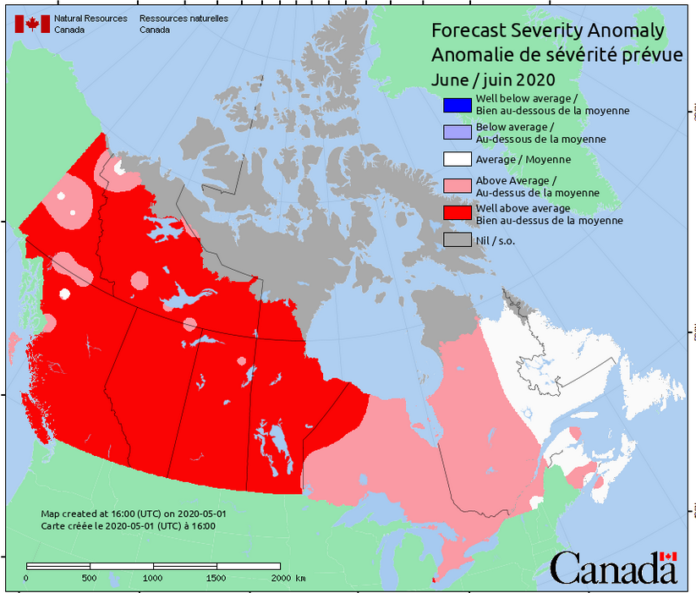
A senior wildfire prevention official is urging residents to be careful this year to avoid adding an out-of-control fire to a pandemic.
Scott Wasylenchuk is the director of land operations for the Saskatchewan Public Safety Agency, the crown corporation responsible for wildfire management in the province.
While firefighters are ready to go should any big fires break out, Wasylenchuk said the province wants to avoid that situation as much as possible.
“Our firefighters now, except for the very, very far north, are back on shift. We’re prepared, we’ve done all our fire training, we’re fire ready” he said.
“Everybody understands we have COVID-19 in Saskatchewan. We do not want any human-caused wildfires if at all possible. All human-caused fires are preventable. They tend to be accidents.”
A few small fires have already sparked this year.
As of press time, the province has one active fire. There have been 12 so far this season, a sharp decline from the 64 usually seen by early May.
This year, however, spring came much later for much of the forested area of the province. Some northern regions, Wasylenchuk said, still have snow on the ground.
According to the province’s interactive wildfire map, many of those dozen wildfires have been small, human-caused burns in the Prince Albert area.
According to federal government data, if residents aren’t careful, the situation could get a lot worse.
Natural Resources Canada (NRCAN) recently released its fire weather forecast for Canada. The forecast ranges from well-below to well-above-average, with well-above-average denoted by bright red.
For June, the forecast severity anomaly for Western Canada, including Manitoba, Saskatchewan and Alberta, is solid red.
“These forecasts are created by looking at the difference between historical fire weather severity … relative to what we’ve projected to the future,” explained Ellen Whitman, a fire research scientist with NRCAN’s northern forestry centre.
“That relative level of risk we’re showing, that anomaly is how far off that forecasted fire weather is relative to the historical observations for the same weather stations.”
That means the NRCAN predictions show a fire weather forecast severity well above average for Saskatchewan for June.
“What we’re showing is it seems quite likely that fire weather, or fire danger, is going to be elevated, especially in June,” she said.
“We’re quite confident about that.”
Predictions were also released for the remaining summer months. While July shows well-above-average conditions for much of the province’s north, most of Saskatchewan will be in the above-average fire risk for that month. The same is true of August, while September’s forecast sees only a small strip stretching across central Saskatchewan as seeing a well-above-average forecast severity anomaly.
Like any forecast, Whitman said, confidence decreases as time goes on.
The forecasts are based on an analysis using predicted weather patters provided by Environment Canada. NRCAN looks at fuel moisture, which is affected by heat and dryness. Really warm weather and increased evaporation can dry out fuel and make fires more likely to burn, Whitman said.
“For most of the summer it looks like there will be an elevated fire danger,” Whitman said.
“There is always some possibility of fire, and if we’re seeing an elevated fire risk, that’s relative to the average. The average isn’t necessarily no fire. Even when we have an average fire year, that still means some fire in places like Saskatchewan.”
While the fire weather is predicted to be severe, the number of fires doesn’t have to be.
“What’s really important to remember is these forecasts only show you what we’re expecting for the weather,” Whitman explained.
“In order to have fires, you need to have ignition, too. If there’s no lightning or people are super careful all summer and there’s no human ignition, we can have a really elevated fire danger but quite low fire activity.”
Wildfires are a natural — and vital — part of the boreal forest ecosystem, Whitman said. But that doesn’t mean they don’t pose a risk to communities.
‘It’s important to think to ourselves, we’ve got to be careful. Fires can be dangerous to people. They are a risk to humans and people’s lives,” she said.
“There is lots people can do to manage that risk. Humans are a source of ignition. It’s an excellent time to remind people that unintentional fires are a burden and a danger to other people.”
That’s the same message Wasylenchuk emphasized. Seeing an elevated fire risk in June is not unusual, he said. The province has three of its own meteorologists that do fire weather and emergency event forecasting, including looking at things such as fire weather severity and predicting areas where lightning might strike. The province also monitors forest dryness and watches changing conditions daily to spot any wildfire danger potential.
“We don’t want to have to respond to any human-caused fires because this puts people at risk,” Wasylenchuk said.
“It puts communities at risk. We really want people to be vigilant when it comes to preventing forest fires in the forested areas and grasslands in and around Saskatchewan.”
While that’s always an important message, the presence of COVID-19 makes it even more vital.
“COVID has an impact,” Wasylenchuk says.
“We don’t want to be evacuating communities.”
He reminded residents burning within 4.5 km of a provincial forest to contact their local forest protection area to get a burn notification so the province knows they’re burning safely.
‘We fully understand farmers need to burn a little bit once in a while, but please be careful,’ Wasylenchuk said.
“We don’t need escaped wildfires on top of COVID.”

